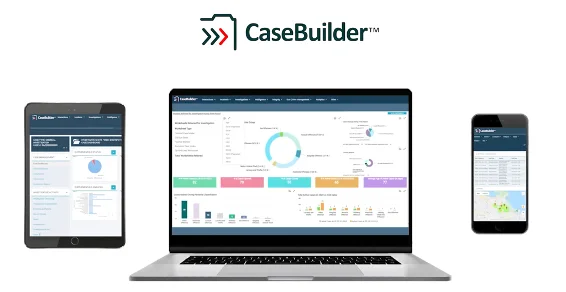Use of force investigations are complex and require both criminal and administrative case folders. In this blog, we discuss the nuances and best practices for conducting bifurcated investigations that are both thorough and compliant.
When a police use of force incident occurs, the proper documentation, review and investigation is extremely important—whether the incident is minor or results in serious injury.
The more serious incidents tend to get quick action. Often, though, not enough immediate attention is provided to the seemingly minor use of force incidents. This can allow things to have a snowball effect. resulting in major problems down the line. Just like the broken windows theory of crime-fighting where police address the small issues in order to prevent bigger ones from occurring, the same can be true for police use of force investigations.
Police use of force investigations can be complicated because you essentially have to manage two different investigations at the same time (criminal and administrative). An officer’s use of force may be justified by law but still fall outside of departmental guidelines. Conversely, it may not be expressly prohibited by departmental guidelines, but it still may be in violation of the law.
In major incidents, it’s common for prosecutors and political leaders to step in, forcing scrutiny of the incident, but in the more routine matters, it often falls to the Police Chief to adjudicate matters. Without a formal process in place to document the incident and ensure a standardized field review is performed, the Chief can be left without critical facts and may not be alerted to trends that deserve early intervention.
In fact, a review of recent controversial use of force incidents seems to indicate that many minor incidents are closed without much follow-up, especially if the incident is not joined by a citizen complaint. But this puts the agency in a bad position if an officer who was involved in seemingly minor incidents that appear to have been glossed over becomes involved in something more serious down the line.
In practice, no use of force incident should ever be viewed as a matter of minor importance. Especially in today’s climate. Moving forward, it’s critical for agencies to establish robust, automatic processes that increase accountability, ensure thorough fact-finding and promote transparency. Throughout the entire process, executive leadership needs to be kept well-informed of investigations as they progress, so they are always in a position to take decisive action where needed or to respond from a position of knowledge to defend their agency and promote positive community relationships.
Before we talk about how police use of force investigations work, let’s examine where these investigations come from.
Police Use of Force Investigations: 2 Sources
Police use of force investigations has two different initiation paths: police incident reports and citizen complaints.
#1. Use of Force Incident Reports
It is understood that there are times when a law enforcement officer might have to use force against an unwilling subject, either in self-defense or to compel compliance. In the overwhelming majority of circumstances, this is simply a necessary aspect of the job and does not connote a violation, or misdeed, on the officer’s part. However, that doesn’t mean the incident should go uninvestigated.
In every use of force situation, the officer must have a systematic process that’s followed to document the incident, even if there are no noticeable injuries or complaints from the individual. A field supervisor should then have a systematic process to perform an initial contemporaneous review and trigger an internal investigation if warranted. Systems should be in place to facilitate this process and track and monitor the workflow.
Before a patrol supervisor can review an incident and make a recommendation on whether to move forward with a full investigation or not, they have to understand the full context of the situation. This means reviewing the incident report, arrest report, medical treatment reports, citizen complaints, and any video or witness statements and compiling the data into a centralized folder.
Once the supervisor understands the facts in the proper context, they can then make a decision: does this incident appear to fall clearly within agency guidelines? Is it outside of the guidelines? Do questions or ambiguity exist?
If the field review concludes it’s clearly within guidelines, the patrol supervisor may sign off, indicating that a follow-up investigation is unnecessary and justifying the rationale for the decision. However, this should not be the final endorsement. A second, higher-level supervisor should conduct their own independent review. If they concur with the field supervisor, only then should the incident be closed, and only upon proper notification to the agency head.
Any supervisor, manager, or agency head must have the authority to immediately trigger a follow-up internal investigation at any point in the process if they have a reason for doubt or lingering questions as to whether the incident is within guidelines. There must always be an open path to trigger a full internal investigation, and supervisors must have the confidence of knowing that they have the agency’s full support when doing so. This should be the case even if no one has complained about the incident, not even the subject.
It’s important to point out that if a subject has sustained a serious physical injury, the incident should always be routed through a full investigation, even if the force used appears to be clearly within guidelines.
#2. Citizen-Submitted Allegations
Police use of force investigations can also initiate from a citizen-submitted excessive force allegation. These allegations might match an incident that has already been reported by the officer themselves. The agency is obviously ahead of the curve when it receives a complaint about an incident that has already been reviewed and has all the facts assembled into a centralized case folder. This should be the goal of the agency, which can be achieved by implementing a process like the one outlined above.
There are times, though, when the citizen makes an allegation that does not have a matching incident report, or the complaint comes in before the process of documentation and review can be completed. These are, naturally, more difficult allegations to deal with since the facts are not immediately available. It leaves your agency vulnerable. It also leaves the Chief wishing the agency had a process that would have informed leadership about the incident right from the get-go.
In these situations, the need for a time-consuming internal investigation is likely, and, while that unfolds, the agency remains vulnerable to second-guessing and criticism. Meanwhile, all the Chief can do is plead for patience while investigators do their work. This type of case will receive the ultimate level of scrutiny and must be properly managed.
Whether it starts from an officer reporting the incident or a citizen complaint, an excessive force allegation leads to the creation of a Force Investigation case that will eventually need to be adjudicated. But before that, the agency has to run not one but two parallel investigations.
Conducting a Bifurcated Use of Force Investigation: 4 Best Practices
The excessive force investigation always runs in two parallel paths: criminal and administrative.
Criminal Investigations
In the criminal case, the police conduct an investigation, prepare documentation and turn it over to the prosecutors. From there, they decide if they will charge the officer or not. That decision leads to the closing of the criminal case.
Administrative Investigations
Administrative cases are all about determining if an officer violated agency policy. This is more of an internal issue that may not only impact the fate of the officer’s assignment or employment status but also identify shortcomings in agency policy, procedures, training and tactics. The administrative case is often delayed until the outcome of the criminal case is determined in order to avoid jeopardizing any potential prosecution.
While smaller agencies might rely on a neighboring agency to oversee the investigation to avoid bias, larger ones will often have a civilian board that helps determine both the outcome and punishment. But it’s not one person or a single case investigator making the decision; it’s an executive board and/or civilian board that must have a system to review and collaborate while deciding how to proceed.
So, with that in mind, here are 4 high-level tips to keep your use of force case organized and compliant as it progresses in parallel paths.
#1. Associate Incident Reports & Complaints
Managing two investigations at the same time for the same matter without tainting a potential criminal prosecution only makes an already burdened caseload harder for agencies.
Police have to accept complaints from citizens, no matter if they are involved and fully informed about an incident or not. For example, if a citizen drives by and catches a brief glimpse of police conducting an arrest while utilizing what they perceive to be excessive force, they might call and report it when they get home later that day. Even though the citizen doesn’t have crucial information, such as what crime was charged, the circumstance of the apprehension, officers’ names or badge numbers, the agency still has to take the complaint seriously and start an investigation while trying to piece things together.
Without a proper system in place, this can be overwhelming. Today’s law enforcement organizations must deal with massive amounts of data, and, while it may seem obvious in this discussion, it can be difficult to immediately recognize that multiple reports relate to the same incident without enough background information or details.
A secure, cloud-based case management system can help you connect the dots faster and associate multiple documents and artifacts into a single organized investigation. You can quickly follow up with complaints and see all the relevant documentation in one place. All documentation is tied together into one parent investigation.
#2. Keep Criminal and Administrative Cases Separate
As mentioned previously, a police use of force investigation runs in two parallel paths. It’s really important to keep these administrative and criminal cases separate.
If you’re going to interview an officer for an administrative investigation, you can’t use that information to prosecute in a court of law. Garrity Rights protect public employees like law enforcement officers from being compelled to incriminate themselves during administrative investigatory interviews.
#3. Resolve Cases Together
While these two cases have to start separately, they should be resolved in sync with each other.
If the agency prematurely closes the administrative investigation by terminating the employee, they have lost all obligations from that employee to cooperate with the agency, and that could hamper the progress of the criminal investigation. This also puts an agency at liability. If the officer is cleared of any criminal wrongdoing, they will likely seek to recover damages for wrongful termination of employment and use the findings of the criminal case as leverage.
On the flip side, it wouldn’t make sense for an agency to clear an officer of administrative charges only to have the prosecutor convict the officer later in the criminal investigation. It’s typically best practice to allow the criminal investigation to close first before a final adjudication is reached on the administrative case.
In the end, of course, both cases require a conclusion. The criminal investigation will decide if the officer violated the law and should be charged. The administrative one will decide whether the officer operated within policy, and if not, how they should be disciplined, as well as if policy or training needs to be revisited.
#4. Keep Citizens Updated
Police use of force is a sensitive topic today. Law enforcement’s mission is to serve and protect citizens. So, when excessive force by those who are meant to protect enters the picture, public safety as a whole is in a compromised position. The entire agency and community can suffer, as we have unfortunately seen play out recently.
In truth, serious excessive force incidents are rare. When they do occur, agencies typically take them very seriously and follow up on allegations quite thoroughly. However, they may neglect to communicate that to the complainant or public in an effective way. This makes citizens think the police don’t care, which in turn increases friction in the community and results in less cooperation with the police.
Building trust is why transparency is so important. The public must be informed and have reliable data readily available to them in order to create trust. One way to accomplish this is for agencies to consider participating in NIBRS Use of Force data collection and contribute their monthly use of force data so it’s available and can be compared to the use of force statistics from other communities.
Frequent communication and transparency will make your community feel important, heard and protected.
When a citizen makes a complaint, you should:
- Acknowledge in writing that you received the complaint. Provide a copy for the citizen
- Provide information about the case number and name and contact information of the assigned investigator so they can follow up.
- Take steps to protect the citizen’s personal identifying information and communicate those steps to the citizen.
- Provide an explanation to the citizen on the process for internal investigations so they have something to base expectations around.
- Periodically reach out to the citizen in writing at predetermined times and provide case updates.
- Inform the citizen if the case is transferred between investigators or referred to other departments.
- Inform the citizen and any witnesses when a case is dispositioned and the reasoning behind the disposition.
Conclusion
There is a lot to keep track of in police use of force investigations: two parallel cases to manage, citizens to keep informed, and multiple internal and external decision-makers. It’s difficult to do this effectively using a paper-based system – especially on top of a regular caseload.
Cloud-based case management software provides tools that help streamline bifurcated investigations. So, you can centralize reporting, easily see incidents in context and collaborate with investigators and supervisors for quick access and review.
CaseBuilder’s ™ incident-driven smart folders, worksheet templates, and reporting capabilities help law enforcement agencies function more efficiently and better interface with their community. Learn more.




